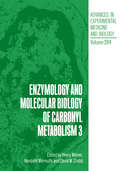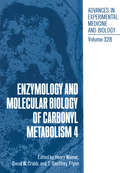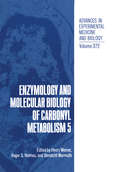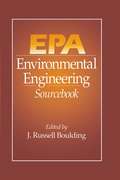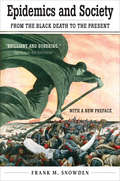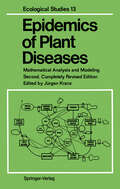- Table View
- List View
Enzymology and Molecular Biology of Carbonyl Metabolism 3 (Advances in Experimental Medicine and Biology #284)
by David W. Crabb Henry Weiner Bendicht WermuthThe Fifth International Workshop on the Enzymology and Molecular Biology of Carbonyl Metabolism was held at Purdue University in June, 1990. This represents the fifth time that I had the privilege of organizing the scientific program. It was the first time that I actually hosted the meeting. I wish to salute my four previous co-organizers and the thousands of scientists who have hosted other meetings. It is much easier to arrange the scientific program and edit the proceedings. No local organization could occur without the help of ones research group and, in this case, my wife. I sincerely thank Esther and my research group for their advise and help. At this Workshop, similar to the preceeding ones, much new information was presented. It was apparent how molecular biological techniques were influencing the direction of the research on the three families of enzymes discussed. It also was apparent that not all biochemical problems could be solved by using these techniques. Many of the presentations showed how important advances still could be made using more traditional biochemical approaches.
Enzymology and Molecular Biology of Carbonyl Metabolism 4 (Advances in Experimental Medicine and Biology #328)
by Henry Weiner David W. Crabb T. Geoffrey FlynnThe Sixth International Workshop on the Enzymology and Molecular Biology of Carbonyl Metabolism was held outside of Dublin, Ireland at the end of June, 1992. Prof. Keith Tipton, Chairman of the Biochemistry Department at Trinity College, kindly agreed to host the meeting. On behalf of all of us who attended I wish to extend our sincere thanks to the whole Tipton family for making us feel so welcome in Ireland. It has been a decade since the frrst workshop was held in Bern, Switzerland. The scope of the meetings reflected somewhat the changes that have occurred in biochemistry during the past decade. At the first meeting primarily enzymes and their properties were discussed. At this last meeting many of the talks centered on gene regulation as well as more traditional aspects of enzymology and metabolism. During the past decade site directed mutagenesis to probe for the active site of an enzyme has become part of traditional enzymology; this was virtually unheard of at our frrst meeting. Many of the presenters now used this tool to study some aspect of structure and function of one of the three carbonyl metabolizing enzymes.
Enzymology and Molecular Biology of Carbonyl Metabolism 5 (Advances in Experimental Medicine and Biology #372)
by Henry Weiner Roger S. Holmes Bendicht WermuthSince the inception of these meetings in 1982, they have always been a satellite of the International Society for Biomedical Research on Alcoholism meeting. At our 1992 meeting in Dublin we learned that the next ISBRA meeting would be held in Brisbane, of all our previous meetings, I was very concerned Australia. As the scientific organizer about holding a meeting in the Southern Hemisphere for fear that many of our potential participants would not travel that far. I am pleased to say that I was proven to be incorrect. Nearly 90 scientists from a dozen countries participated at our seventh conference. At this meeting, like at all our previous ones, much new information about the three enzyme systems was presented. Of equal importance was, like at all our previous meetings, the extreme openness of the participants to discuss ideas, future directions and unpublished data. On behalf of all the participants I wish to express our sincere thanks to our Massey University colleagues for the excellent organization of this Palmerston North, New Zealand meeting. These included Kathryn Kitson, Michael Hardman, Paul Buckley, Trevor Kitson and Len Blackwell. At this meeting a few new innovations were introduced. Though posters are common at many meetings, bush walks and visits to nature preserves to see kiwi birds Our hosts were able to secure support from the International Union of Biochemistry are not.
Enzymology and Molecular Biology of Carbonyl Metabolism 6 (Advances in Experimental Medicine and Biology #414)
by Henry Weiner Ronald Lindahl David W. Crabb T. Geoffrey FlynnSince 1982, our ever-expanding group of investigators has been meeting in exotic parts of the world to discuss aspects of three enzyme systems. The 1996 meeting was no exception. Nearly 90 scientists from 15 countries met in the small city of Deadwood, South Dakota, for four days of stimulating talks and posters and incredible scenery. Once more this meeting reflected the changing trends in biochemical research. At the 1982 meeting most of the speakers discussed isolating new enzymes and trying to characterize them. At this meeting many speakers discussed interpretations of three-dimensional struc ture or regulatory elements of the genes controlling for the tissue-specific expression of the enzyme. Hopefully, readers will find the proceedings of the meeting to be of interest. Though they reflects the scientific information that was presented at the meeting, they do not indicate the level of personal interactions that went on during the meeting. Once again, the willingness of the participants to discuss unpublished data and to share thoughts about the future directions of their research helped make this, like our previous seven meetings, a special scientific experience for those who attended.
Enzymology and Molecular Biology of Carbonyl Metabolism 7 (Advances in Experimental Medicine and Biology #463)
by Henry Weiner Edmund Maser David W. Crabb Ronald LindahlPrior to the start of the eighth meeting, I had the good sense to ask Professor Rosa Angela Canuto of Turin, Italy if she would help me organize the ninth meeting. She quickly suggested that both she and Dr. Guiliana Muzio, also of Turin, help plan the meet ing. Each of our previous eight meetings was a unique experience for the participants. The science was always outstanding and the presentations and discussions were excellent. By moving each meeting to a different part of the world we were able to experience exciting foods and cultural aspects of the world in addition to the science. The ninth meeting was no exception. We met from June 18 to 22 in the small mountain city of Varallo, Italy, the birth place of Dr. Canuto. Holding the scientific sessions in a several-hundred-year-old converted mansion and having an afternoon trip to either Lago Maggiore or Monte Rosa made some aspects of this meeting extremely memorable. An additional unique aspect of the social portion of the meeting was our ability to invite the townspeople to share with us a concert performed in an old church. Though the social and cultural aspects of the meeting were outstanding, the pur pose of the meeting was to exchange scientific information about the status of the three enzyme systems.
Enzymology of Complex Alpha-Glucans
by Felix NitschkeGlycogen and Starch: So Similar, yet so Different. Both carbohydrates are central to the primary metabolism of a large part of the living kingdom. Generally, animals, fungi, and bacteria store glycogen, while plants largely rely on starch. This book provides a broad and current view on both glycogen and starch, in lower and higher organisms. Beside biochemistry, physiology and regulation of glycogen and starch metabolism, the reader can expect an insight into glycogen storage diseases, select methods and relevant techniques. While significant progress has been made in both fields, this volume emphasizes an opportunity of collaboration for researchers working on a major intersection of the living world.
Enzymology of Complex Alpha-Glucans
by Felix NitschkeGlycogen and Starch: So Similar, yet so Different. Both carbohydrates are central to the primary metabolism of a large part of the living kingdom. Generally, animals, fungi, and bacteria store glycogen, while plants largely rely on starch. This book provides a broad and current view on both glycogen and starch, in lower and higher organisms. Beside biochemistry, physiology and regulation of glycogen and starch metabolism, the reader can expect an insight into glycogen storage diseases, select methods and relevant techniques. While significant progress has been made in both fields, this volume emphasizes an opportunity of collaboration for researchers working on a major intersection of the living world.
The Enzymology of the Cell Surface Tension at the Cell Surface (Protoplasmatologia Cell Biology Monographs #2 / E / 4,5)
by Aser Rothstein Edmund N. Harveyobvious properties, its structure, composition, electrical properties, me chanical properties, and most particularly, its permeability properties. None of these properties are obviously associated with surface enzymes. What are the functions of the cell surface that may require the presence of enzymes? From a purely hypothetical point of view, the cellular activities in which cell surface enzymes are potentially functional can be divided into two categories; first, those activities related to the production and maintenance of the cell surface structure itself, and second, those activities which are concerned with interactions between the cell and its environment. During growth of a cell, as it enlarges, new structural ma terial must be synthesized and assembled in the cell membrane. Although it is conceivable that new structural material is synthesized in the interior of the cell, it is difficult to visualize its complete synthesis and final assembly in the periphery of the cell, without the assistance of enzymes at the site. In the case of non-growing cells, although no net synthesis of new structural material is necessary, the turnover of the various components by a continuous degradation and resynthesis must be considered as a pos sibility.
Enzymtechnologie (Springer-Lehrbuch)
by Peter Gacesa John HubbleDie Entwicklung der Immobilisierungstechniken für Enzyme seit den 50er Jahren hat zu einem Boom bei der industriellen Anwendung von Enzymen geführt und hat an Wissenschaftler mit verschiedenstem akademischen Hintergrund die Anforderung gestellt, in der Enzymtechnologie zu arbeiten. Dieses Buch wendet sich an Studenten sowie in der Industrie tätige Wissenschaftler, die aus den Fachbereichen Chemieingenieurwesen, Chemie, Biochemie, Mikrobiologie/Biologie, Technische Biologie sowie Biotechnologie kommen und ein allgemeines Interesse an Enzymen haben. Es bringt dem Ingenieur die Feinheiten der Enzyme sowie das Potential der Techniken in der Molekulargenetik nahe, mit denen diese Katalysatoren für spezifische Anwendungen geschneidert werden können. Für jene mit einem chemisch/biochemischen oder biologischen Hintergrund werden in diesem Buch vor allem die biochemisch-technischen Beschreibungen, wie kinetische Eigenschaften und Reaktorkonstruktion, von Nutzen sein.
Eocene Biodiversity: Unusual Occurrences and Rarely Sampled Habitats (Topics in Geobiology #18)
by Gregg F. GunnellInitially, this work was designed to document and study the diversification of modern mammalian groups and was quite successful and satisfying. However, as field and laboratory work continued, there began to develop a suspicion that not all of the Eocene story was being told. It became apparent that most fossil samples, especially those from the American West, were derived from similar preservational circumstances and similar depositional settings. A program was initiated to look for other potential sources of fossil samples, either from non-traditional lithologies or from geographic areas that were not typically sampled. As this program of research grew it began to demonstrate that different lithologies and different geographic areas told different stories from those that had been developed based on more typical faunal assemblages. This book is conceived as an introduction to non-traditional Eocene fossils samples, and as a place to document and discuss features of these fossil assemblages that are rare or that come from rarely represented habitats.
Eocene-Oligocene Climatic and Biotic Evolution
by Donald R. Prothero William A. BerggrenThe transition from the Eocene to the Oligocene epochs was the most significant event in earth history since the extinction of dinosaurs. As the first Antarctic ice sheets appeared, major extinctions and faunal turnovers took place on the land and in the sea, eliminating forms adapted to a tropical world and replacing them with the ancestors of most of our modern animal and plant life. Through a detailed study of climatic conditions and of organisms buried in Eocene-Oligocene sediments, this volume shows that the separation of Antarctica from Australia was a critical factor in changing oceanic circulation and ultimately world climate. In this book forty-eight leading scientists examine the full range of Eocene and Oligocene phenomena. Their articles cover nearly every major group of organisms in the ocean and on land and include evidence from paleontology, stable isotopes, sedimentology, seismology, and computer climatic modeling. The volume concludes with an update of the geochronologic framework of the late Paleogene.Originally published in 1992.The Princeton Legacy Library uses the latest print-on-demand technology to again make available previously out-of-print books from the distinguished backlist of Princeton University Press. These editions preserve the original texts of these important books while presenting them in durable paperback and hardcover editions. The goal of the Princeton Legacy Library is to vastly increase access to the rich scholarly heritage found in the thousands of books published by Princeton University Press since its founding in 1905.
Eosinophils: Methods and Protocols (Methods in Molecular Biology #2241)
by Garry M. WalshThis second edition of Eosinophils: Methods and Protocols updates several techniques from the first edition together with novel in vitro and in vivo-based methodologies. Written by internationally recognized expert authorities, this volume provides vital techniques from eosinophil purification to experimental modelling, with each technique spelled out in clear and straightforward terms, assuming no previous knowledge of the method and without necessitating sourcing additional information elsewhere. Written in the highly successful Methods in Molecular Biology format, chapters include introductions to their respective topics, lists of the essential materials and reagents, step-by-step, readily reproducible laboratory protocols, with tips on troubleshooting and avoiding known pitfalls. Authoritative and practical, Eosinophils: Methods and Protocols, Second Edition provides the practical means to extend our knowledge of eosinophil function in health and disease, underpinning research that may in turn lead to new hypotheses for future examinations into the role of this intriguing and enigmatic leukocyte.
Eozänkorallen aus Österreich (Sitzungsberichte der Österreichischen Akademie der Wissenschaften)
by Othmar KühnEPA Environmental Engineering Sourcebook
by J. Russell BouldingThe U.S. Environmental Protection Agency (U.S. EPA) publishes several series of documents that provide up-to-date information about environmental site assessment and remediation. The EPA Environmental Engineering Sourcebook includes papers and bulletins that focus on remediation of soil and groundwater, making them available in a convenient form.This book compiles thirty-five documents- written by recognized leaders - on major methods and promising new techniques for hazardous waste treatment and site remediation. Each chapter evaluates the type of contaminant and site characteristics needed to select a technology for use at hazardous waste sites.The EPA Environmental Engineering Sourcebook presents EPA documents in an easy-to-use, concise format. It contains numerous graphs, charts and figures that make it an important resource for those involved in environmental protection, site remediation, and site assessment. FeaturesContains chapters written by recognized leadersExamines major methods as well as assesses new techniques for hazardous waste treatment and site remediationPresents information in an easy-to-use, concise formatEvaluates each type of contaminant and site characteristics for selecting technology at hazardous waste sites
EPA Environmental Engineering Sourcebook
by J. Russell BouldingThe U.S. Environmental Protection Agency (U.S. EPA) publishes several series of documents that provide up-to-date information about environmental site assessment and remediation. The EPA Environmental Engineering Sourcebook includes papers and bulletins that focus on remediation of soil and groundwater, making them available in a convenient form.This book compiles thirty-five documents- written by recognized leaders - on major methods and promising new techniques for hazardous waste treatment and site remediation. Each chapter evaluates the type of contaminant and site characteristics needed to select a technology for use at hazardous waste sites.The EPA Environmental Engineering Sourcebook presents EPA documents in an easy-to-use, concise format. It contains numerous graphs, charts and figures that make it an important resource for those involved in environmental protection, site remediation, and site assessment. FeaturesContains chapters written by recognized leadersExamines major methods as well as assesses new techniques for hazardous waste treatment and site remediationPresents information in an easy-to-use, concise formatEvaluates each type of contaminant and site characteristics for selecting technology at hazardous waste sites
EPFL Lectures on Conformal Field Theory in D ≥ 3 Dimensions (SpringerBriefs in Physics)
by Slava RychkovThis primer develops Conformal Field Theory (CFT) from scratch, whereby CFT is viewed as any conformally-invariant theory that describes a fixed point of a renormalization group flow in quantum field theory.The book is divided into four lectures: Lecture 1 addresses the physical foundations of conformal invariance, while Lecture 2 examines the constraints imposed by conformal symmetry on the correlation functions of local operators, presented using the so-called projective null cone – a procedure also known as the embedding formalism. In turn, Lecture 3 focuses on the radial quantization and the operator product expansion, while Lecture 4 offers a very brief introduction to the conformal bootstrap. Derived from course-based notes, these lectures are intended as a first point of entry to this topic for Master and PhD students alike.
Ephemeridenrechnung Schritt für Schritt: Sonnenaufgang und Co. bestimmen leicht gemacht
by Dieter RichterDas vorliegende Buch vermittelt die Grundkenntnisse der Ephemeridenrechnung. Ausgehend von den Kepler’schen Gesetzen erfolgt die Berechnung der Koordinaten der Planeten in der Bahnebene. Über eine Anzahl von Transformationen ermittelt man die Koordinaten im Horizontsystem und erhält damit die Winkel, die an einem Teleskop einzustellen sind, um einen bestimmten Planeten zu sehen. Dabei werden das Zweikörper- oder Kepler-Problem und die Berechnung weiterer Parameter, wie die Bahngeschwindigkeit und der Abstand der Planeten von der Sonne, geschlossen hergeleitet, ausführlich erklärt und am Beispiel einzelner Planeten vorgerechnet. Ergänzend dazu, und über das Zweikörperproblem hinausgehend, wird die Berechnung der Mondposition erläutert.Außerdem werden die wichtigsten Einflüsse auf die Planetenbahnen, die im Rahmen der Berechnung als Zweikörperproblem nicht berücksichtigt wurden, erklärt und deren Wirkung auf die Planeten abgeschätzt. Zum besseren Verständnis ist eine Reihe von Beispielen beschrieben und vorgerechnet, bei denen die erworbenen Kenntnisse angewendet werden.Das Buch wendet sich an Studierende der Naturwissenschaften, Physik, Astronomie und an Amateurastronomen sowie naturwissenschaftlich Interessierte, die schon immer einmal erfahren wollten, woher man denn weiß, wann die Sonne aufgeht..
Epiblast Stem Cells: Methods and Protocols (Methods in Molecular Biology #1074)
by Ramiro AlberioIn Epiblast Stem Cells: Methods and Protocols, expect researchers in the field provide a detailed collection of techniques and protocols useful to the study of the biology of the pluripotent epiblast. These include methods and techniques used to study epiblast development in different amniotes. This collection brings together contributions from the fields of embryology, stem cell biology and developmental biology together, providing a single volume with detailed procedures for the isolation and culture of epiblasts at different stages of development, and techniques for the study of differentiation into specific lineages. Written in the highly successful Methods in Molecular Biology series format, chapters include introductions to their respective topics, a complete list of the necessary materials and reagents, detailed laboratory protocols, and extensive notes providing suggestions on troubleshooting and how to overcome common difficulties. Comprehensive and cutting-edge, Epiblast Stem Cells: Methods and Protocols serves as a resource to individuals interested in studying the biology of pluripotent cells.
Epiblast Stem Cells: Methods and Protocols (Methods in Molecular Biology #2490)
by Pierre OsteilThis book aims to deliver the most up-to-date protocols in using epiblast stem cells (EpiSC) to answer critical questions on mammalian development. Beginning with a section on the spectrum of mouse primed pluripotent stem cells, the volume continues with chapters on toolkits to characterize and study primed stem cells, as well as primed stem cells to engineer gastrulation models. Written for the highly successful Method in Molecular Biology series, chapters include introductions to their respective topics, lists of the necessary materials and reagents, step-by-step, readily reproducible laboratory protocols, and tips on troubleshooting and avoiding known pitfalls. Authoritative and practical, Epiblast Stem Cells: Methods and Protocols serves as an ideal guide to overcome the reproducibility problem by gathering detailed state-of-the-art protocols to perform comprehensive analyses, enabling the reader to opt for the appropriate cell type to model the epiblast.
The Epic History of Biology
by Anthony SerafiniThe search for our elusive human origins and an understanding of the mysteries of the human body have challenged the most inquisitive and imaginative thinkers from Egyptian times through the twentieth century. In The Epic History of Biology, Anthony Serafini - a distinguished philosopher and historian of science - regales the reader with the triumphs and failures of the geniuses of the life sciences. The subtleties of the animal kingdom - anatomy, zoology, and reproduction - along with the complexities of the plant kingdom, have fascinated humanity as far back as 5000 years ago. Astounding ancient knowledge of the arcane curing powers of herbs as well as early experimentation with different chemical combinations for such purposes as mummification led to today's biological technology. Innovative pioneers such as Aristotle, Galen, Hippocrates, and Vesalius challenged the limits of knowledge and single-mindedly pursued their work, often in the face of blind superstition. In superb, lyrical prose Serafini recreates the ideas and theories of these revolutionaries from ancient times through today, against the backdrop of the dogma and prejudices of their time. He explores the inspired revelations that gave birth to such discoveries as the controversial theory of evolution, the humble origins of genetics, the fantastic predictions of quantum mechanics, and the infinite promise of computer technology. Even today the biological sciences are undergoing rapid and kaleidoscopic changes. Every new insight gives rise to a myriad of new ethical questions and responsibilities. The Epic History of Biology confronts these issues head on and predicts the wondrous new directions biology will follow.
Epidemics and Society: From the Black Death to the Present (The Open Yale Courses Series)
by Frank M. SnowdenA wide-ranging study that illuminates the connection between epidemic diseases and societal change, from the Black Death to Ebola This sweeping exploration of the impact of epidemic diseases looks at how mass infectious outbreaks have shaped society, from the Black Death to today. In a clear and accessible style, Frank M. Snowden reveals the ways that diseases have not only influenced medical science and public health, but also transformed the arts, religion, intellectual history, and warfare. A multidisciplinary and comparative investigation of the medical and social history of the major epidemics, this volume touches on themes such as the evolution of medical therapy, plague literature, poverty, the environment, and mass hysteria. In addition to providing historical perspective on diseases such as smallpox, cholera, and tuberculosis, Snowden examines the fallout from recent epidemics such as HIV/AIDS, SARS, and Ebola and the question of the world’s preparedness for the next generation of diseases.
Epidemics of Plant Diseases: Mathematical Analysis and Modeling (Ecological Studies #13)
by Jürgen KranzIn this volume experts present the latest status of mathematical and statistical methods in use for the analysis and modeling of plant disease epidemics. Topics treated are - methods in multivariate analyses, ordination and classification, - modeling of temporal and spatial aspects of air- and soilborne diseases, - methods to analyse and describe competition among subpopulations, e.g. pathogen races and - their interaction with resistance genes of host plants - assemblage and use of models - mathematical simulation of epidemics. New chapters on the modeling of the spreading of diseases in air and in soil are included in this second edition.
Epidemien und Pandemien in historischer Perspektive: Epidemics and Pandemics in Historical Perspective (Edition Centaurus – Neuere Medizin- und Wissenschaftsgeschichte)
Im Zentrum dieses Sammelbandes stehen neue Forschungsergebnisse interdisziplinärer Autorinnen und Autoren aus sieben Ländern zum Thema Seuchen. Seuchen verbreiten zunächst Unsicherheiten, so dass historische Beispiele und Denkweisen herangezogen werden, um Gefahren zu erkennen und Gegenmaßnahmen zu treffen. Solche Traditionen lassen sich über Jahrhunderte zurück verfolgen. So werden in diesem Band die Rekonstruktion von Fakten in Zeit und Raum (global vs. local) sowie die Einflüsse auf das Kulturleben (cultural impact) und die der Wissenschaftsgeschichte (Science studies) analysiert. Einführend und abschließend werden Forschungsstand und -perspektiven zur Sozialgeschichte der Medizin diskutiert.
Epidemiological and Molecular Aspects on Cholera (Infectious Disease)
by T. Ramamurthy and S.K. BhattacharyaThough cholera is an ancient disease, its perennial occurrence in several parts of the world has attracted many researches to find ways and means to combat the disease. The prevailing seventh pandemic cholera is dominating since 1961, but the dimension of the disease has taken several silhouettes, as the genetic structure and functions of the Vibrio cholerae has changed to a great extent. Several recent studies have shown that transformation of the pathogen at the molecular level has ameliorated several cholera outbreaks and epidemics of with successive new clones of V. cholerae. This comprehensive compilation, written by eminent international researchers reviews the epidemiology of cholera in Africa, Asia, Russia and Latin Americas. The other chapters contributed by acclaimed authors cover various aspects on evolution, polysaccaharide biosynthesis, SXT element, integrons, small molecule signalling systems, flagellar synthesis, filamentous phages, pathogenic role of proteases and hemolysin, and other putative virulence factors. In addition, ecology of V. cholerae and management of cholera were also discussed in detail. This book will be good source of information to all researchers with interests in infectious diseases, microbiology and molecular biology.

